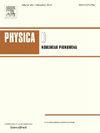Data-driven model identification near a supercritical Hopf bifurcation using phase-based approaches
IF 2.7
3区 数学
Q1 MATHEMATICS, APPLIED
引用次数: 0
Abstract
A data-driven model identification strategy is developed for dynamical systems near a supercritical Hopf bifurcation with nonautonomous inputs. This strategy draws on phase–amplitude reduction techniques, analytically relating the phase and amplitude response curves to the terms of the controlled Hopf normal form. Fitting can be performed by recording the system output during the relaxation to the stable limit cycle after applying as few as two carefully timed pulse inputs. Unlike standard phase-based model identification strategies, the resulting model is valid in the neighborhood of the Hopf bifurcation, rather than just in a close vicinity of the unperturbed limit cycle. This strategy is illustrated in two examples with relevance to circadian oscillations. In each example, the proposed model identification strategy allows for the formulation, solution, and implementation of a closed loop nonlinear optimal control problem.
基于相位的超临界Hopf分岔数据驱动模型识别方法
针对具有非自治输入的超临界Hopf分岔附近的动态系统,提出了一种数据驱动的模型识别策略。该策略利用相幅降低技术,将相位和幅值响应曲线解析地与受控Hopf范式相关。拟合可以通过记录系统在松弛到稳定极限循环期间的输出来执行,在应用少至两个精心定时的脉冲输入之后。与标准的基于相位的模型识别策略不同,所得到的模型在Hopf分岔的邻域有效,而不仅仅是在无扰动极限环的近邻域中有效。在两个与昼夜节律振荡相关的例子中说明了这一策略。在每个示例中,所提出的模型识别策略允许闭环非线性最优控制问题的制定,解决和实现。
本文章由计算机程序翻译,如有差异,请以英文原文为准。
求助全文
约1分钟内获得全文
求助全文
来源期刊

Physica D: Nonlinear Phenomena
物理-物理:数学物理
CiteScore
7.30
自引率
7.50%
发文量
213
审稿时长
65 days
期刊介绍:
Physica D (Nonlinear Phenomena) publishes research and review articles reporting on experimental and theoretical works, techniques and ideas that advance the understanding of nonlinear phenomena. Topics encompass wave motion in physical, chemical and biological systems; physical or biological phenomena governed by nonlinear field equations, including hydrodynamics and turbulence; pattern formation and cooperative phenomena; instability, bifurcations, chaos, and space-time disorder; integrable/Hamiltonian systems; asymptotic analysis and, more generally, mathematical methods for nonlinear systems.
 求助内容:
求助内容: 应助结果提醒方式:
应助结果提醒方式:


